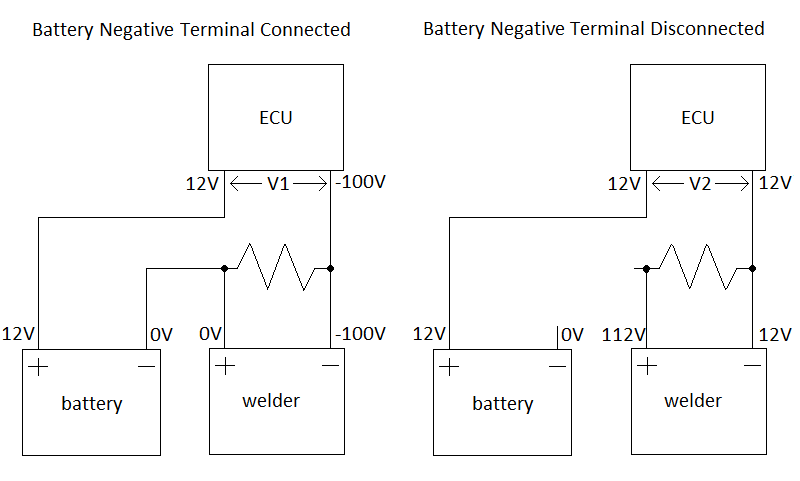Last Updated 6/01/2021
Speculation runs rife regarding whether the negative terminal of a vehicle’s battery should be disconnected before welding on that vehicle. The reason to do it is that it helps to prevent damage to the vehicle’s ECU and other electronics. Many people believe the negative terminal should be disconnected but cannot explain why it should be done. Other people believe disconnecting the battery terminal has no impact on the ECU since the ECU is still connected on both terminals and the affect of disconnecting the battery only isolates the battery and nothing else. They believe the idea to disconnect is simply an old wives’ tale with no valid reasons to substantiate it. So who is right?
Electrical Principles
To help explain what’s happening we need to understand a couple of principles: Ohm’s Law and Kirchhoff’s Circuit Laws. I’m going to explain them very simply as they relate to this problem.
Ohm’s Law: This is usually presented as the formula V= iR where V is voltage, i is current and R is resistance. It tells us that voltage is required for current to flow. If there is current flowing through a conductor then there must be a voltage across that conductor. It also tells us that current always flows when there is voltage applied across a resistance, which means current will flow everywhere through parallel paths and not just take the path of least resistance.
Kirchhoff’s Circuit Laws: This law states that the sum of the voltages around a continuous electrical loop must be zero and the sum of the currents into and out of an electrical node is zero. Regardless of the current flowing, regardless of parallel or alternative loops, the voltages around every unique loop must sum to zero and the currents through each node must sum to zero. This is analogous to, if you walk around a track which has varying elevation, no matter what route you take on that track and what levels of elevation you reach, if you end up at the same spot you started then your net elevation change is zero. Or if many people are walking into an intersection where you can turn left or right, then the sum of the people going left plus people going right is equal to the number of people who entered the intersection.
Welding Circuit
Below is a circuit diagram that depicts welding a vehicle. On the left is welding with the negative battery terminal connected and on the right is welding with the negative battery terminal disconnected. The resistor represents the car body. I have assumed the car battery voltage is 12V and the welder voltage is 100V. The actual voltages are irrelevant. The point is to see whether welding could damage the ECU and whether disconnecting the negative battery terminal would reduce that risk. All voltages are measured with respect to the battery’s negative terminal. The box labelled “ECU” is the engine control unit or engine management. This is the device we are trying to protect.
V1 is the voltage across the ECU with the negative battery terminal connected whilst welding. V2 is the voltage across the ECU with the negative battery terminal disconnected whilst welding. Kirchhoff’s laws and Ohm’s laws resolve the voltage at each point. The left side has a closed loop through the ECU where Kirchhoffs voltage law easily verifies the voltage across the ECU. The right side has an open loop where Kirchoff’s current law dictates that no current flows through the ECU and Ohm’s law determines that the voltage across the ECU is zero. Similarly Ohm’s law could be used in isolation with the open circuit interpreted as an infinite resistance.
So from the diagram we see that:
V1 = 112V
V2 = 0V
We see that in the left circuit the ECU is suffering from overvoltage and could be damaged. It is designed for 12V yet has 112V across it. The right circuit, with the negative battery terminal disconnected, there is no voltage across the ECU and therefore it does not experience any overvoltage.
But welders produce less than 100 volts you say? It doesn’t matter. I would have liked to use “x” for battery voltage and “y” for welder voltage and shown V1 > V2 but that might have been difficult to follow. The voltages are irrelevant. The point is V1 > V2.
You might think that the metal sheeting of a car body is such a good conductor that it will never be able to generate any significant voltage drop at the current levels typical of welding. What about all the transitions and joins, for example where a door bolts onto the main body? Or the body bolts onto the chassis? What is the capacitance, inductance and overall impedance of the car body? Impedance describes the complex ratio between voltage and current for alternating currents. When you first strike the welder it yields a step function which would generate a reaction different to what the steady state DC resistance would predict. A step function is made up of many high frequency components. Not only are there many high frequencies present, but the voltage would be high when first striking the arc. Before welding starts the voltage floats up to the open circuit voltage which is typically between 30 to 100V. When first striking the arc the full open circuit voltage is applied between the welding rod and the earth clamp. I’d suggest that ECU damage is most likely when first striking the arc and not during steady DC current flow.
You might argue that adequate earthing will maintain the body at zero potential throughout. Ohm’s law tells us that if current is flowing there must be voltage regardless of your earthing. Further, earthing does not control the resistance through the body and thus does not necessarily prevent potentially large voltage drops.
From this evaluation it is confirmed that welding a vehicle does risk damage to the ECU and disconnecting the battery’s negative terminal will mitigate that risk.
Why Does This Happen?
The problem lies with the ECU and the welder sharing a single conductor – the vehicle’s body. For the welder to push current through the body, it must impose a voltage across it regardless of how good your earthing is (Ohm’s law). With the battery connected there is a closed electrical loop where the voltage across the vehicle’s body could add to the battery’s voltage and cause an overvoltage condition at the ECU. With the battery’s negative terminal disconnected, the loop is broken, both terminals of the ECU will float to the same voltage and no overvoltage will occur regardless of the voltage across the vehicle’s body.
How to Minimize the Risk When Welding
– Disconnect the battery’s negative terminal. This breaks the loop through the battery so that possible overvoltages are reduced.
– Place the welder’s earth as close as possible to your welding work and ensure the earth has secure electrical contact with the vehicle. This minimizes the potential for voltage spikes through the vehicle.
– Some suggest disconnecting airbag connectors, although I have not heard of airbags being a problem if the battery is disconnected.
Any References to Verify?
The body repair section of the Toyota Hilux 05-10 Service and Repair Manual states:
“When welding, there is a danger that electrical components will be damaged by the electrical current flowing through the body. Before starting work, disconnect the negative terminal of the battery and ground the welder near the welding location of the body.”
Checkout outbackjoe on facebook
See also:
After Market Add-ons and Other Touring / Camping Stuff
Design Guide for 12V Systems – Dual Batteries, Solar Panels and Inverters
Our Electronic Gadgets for Touring / Camping
Camping / Touring / Travelling Phone and Internet Setup




Ok, you know two basic laws of electronics…
That being said, why would you weld by hooking your welder’s ground strap to the battery ground and then weld on the body ground wire going to the ECU.
If you weld on the bumper, ground to the bumper. If you weld the exhaust, ground the exhaust. Don’t cross weld. Using KVL – Welding current in from ground strap, goes through the material to the electrode. There is no other return path for the electrons to go then there is no problem. If there is any ground or a battery charger or something then all bets are off. If you ground the frame and weld the exhaust then yes, current is going to go through the O2 sensor to the ECU – BAD!
Hey Rob not sure what your point is, can you explain? The analysis above demonstrates that no matter where you ground, there is risk of voltage rise at the ECU. It’s got nothing to do with welding on the ground wire going to the ECU. If you ground the bumper and weld the bumper there is a parallel path for current to flow through the rest of the car which can raise the voltage across the ECU. To mitigate the risk disconnect the battery and ground as close as you can to the welding work. Grounding as close as you can to the welding work minimises the resistance from welding electrode to ground and minimises (but does not eliminate) the current flowing through alternative parallel routes.
Well Joe; Riddle me this, my friend welded a hitch onto a 2006 Explorer and the next day the transmission fried! We installed a new transmission and it was fine for 1.5 years until he welded a push bar on the front and the next day the transmission fried again? Now he just welded exhaust onto a 2005 Nissan Titan and the next day the engine has lost all power and will barely run! I was taught and still claim that if you do not unhook the battery, you can cause damage to electrical components. Now as to all your electrical schematics showing how welding does not hurt, I am an Engineer and I can show you all kinds of formulas indicating that a Bumble Bee cannot fly, but nobody as of yet has informed the bees of this!
Bugger when is your mate gonna learn to disconnect the battery? Three times is enough!
Surely if the Ignition switch is not turned on then how would the current be able to flow through the ecu anyway with the battery connected there still would not be a circuit.?????
Hi Mick how does a vehicle’s security system, remote central locking, keyless entry and keyless start / stop work?
Disconnecting negative terminal minimize risk but doesn’t mean that positive path is in the clean air. There is still possibility that some small load make a loop to the chassis.
Hi dmz if the negative terminal is disconnected there is no return path for current. No current can flow.
If the ignition switch is not turned on , no current could flow.
This not the first time I’ve heard this happen but strangely I’ve never seen a muffler shop disconnect the negative terminal on a car or truck all thou I heard a peice of heavy equipment that got welded had problems afterwards with starting that it had damaged the engine a bearing to lockup
Think about it. Muffler Shops have been gas brazing the pipes from way back in the early automotive days. Plus those big lifts must ground car a lot better than jack stands or blocks or car tires. I have been told Static Electricity can kill an alternator, plus always disconnect the negative battery cable first.
The diagram on the left in the article above does not show the line from battery negative to ECU negative.
Yeah it does. It’s through the resistor. The connection is not zero resistance. That’s the source of the problem actually.
This was given to me in my sophomore year in the University to proof with detailed explanations why it would be necessary to disconnect the negative of a car battery before doing any form of welding. The conclusion was that the culprit for possible, but certain, damages would be UNWANTED VOLTAGE build up.
kudos!
OUTBACKJOE
One doesn’t need a physics expert to understand your explanation.
Does clamping a surge protector to battery clamp help ?
With or without behind connected ?
Hi Dan it might help. But maybe not, because the surge protector is usually connected directly across the battery. See in the circuit diagrams the battery is only 12V but the voltage from the welder can add to the battery voltage. So unless the surge protector negative is installed near the welding work it may not make any difference.
But the diagram is flawed. There is a relay in the ecu positive connection.
Ah Thanks Grob so Toyota are wrong in their service manual, those dumbass engineers and vehicle design experts don’t know crap. But if the ecu has no power how does central locking work? How does the security light flash? How does keyless ignition work? Magic?
The ecu and a lot of sensors are grounded directly to the frame and body of the vehicle as well as through the circuitry. So in your diagram you fail to draw the ecu and other components ground to frame and body that would supply the same connection as the negative post. So the only true way to prevent would be to disconnect wiring to ecu and all other modules.
Hi Hammerdg the resistor is the body and the ecu is connected to it in the diagram. Disconnecting the negative battery terminal breaks the loop regardless of the ecu ground and so protects the ecu.
Hey Joe, I’m also an Electronic Engineering Tech and I have a question/suggestion. I plan on stick welding exhaust (Yes I know it won’t be easy but it is possible with an inverter). I also plan on disconnecting both battery leads and using a battery backup for the computer at the OBD port. By removing both leads doesn’t that float the ECU so that it sees only the battery? I ask because in my case I’ll be running + to the exhaust and – to the welding rod.
Yep I think that will protect the ecu. It will just see the battery. If the welding changes the voltage of the earth the whole ecu and battery will change with it provided the connection via obd is direct to ecu and not via body.
I just want to say thank you to all, I feel so lucky to have resources like this to turn to. Dirk Anderson
so to be totally safe is it necassary to disconnect airbag ecu and battery pos and neg?
Hey Dennis I dunno the Toyota maintenance manual only says to disconnect the negative terminal of the battery, I think people say ECU and airbag just for ass covering. As long as you’re not welding very close to sensitive items and your earth clamp is as close to the welding as possible then I’d be happy with just disconnecting negative terminal.
Thanks Joe, some of the people that I read here are anxious to argue with anyone who might listen to their point of view! (regardless of the validity of the point they try to make)
I found the information that you have given to be interesting and very directly relevant to what I need to continue my project.
GOD Bless
Thanks gem glad some stuff here is helpful for ya
As a qualified professional electrical engineer, I was very pleased with the information your provided. I am amazed that some of the contributors are so fussed about disconnecting the negative terminal of the battery before arc welding. Its such a trivial task!
Years ago,when alternators replaced DC generators in vehicals, it was widely accepted that the negative terminal of the battery should be disconnected before connecting a charger, since it was possiblle that the diodes in the alternator could be damaged if the 240 volts AC leaked through the charger and was applied between the alternator and ground. Although diodes today can stand much higher reverse voltages, I still lift the negative connection from the battery before charging.
Best Regards
Ed
Before I work on anything and have my doubts I listen to the experts like you and not the know it alls. My wife’s uncle’s friend says he leaves ground connected so he can listen to radio while he welds gas tank.
Haha that guy sounds like someone you should be listening to.
if i were i just follow the manual or to make it safe and to avoid such resetting of system involve. the best thing is to remove the exhaust pipe that you are going to weld